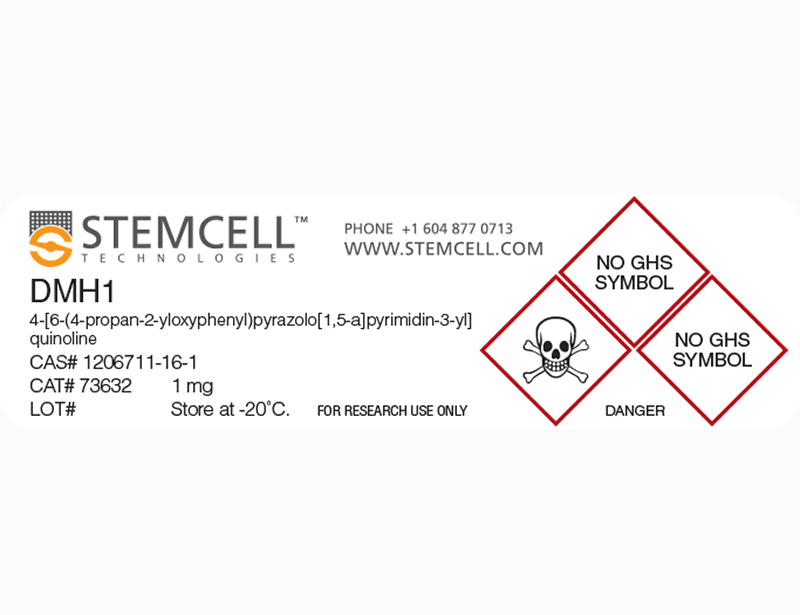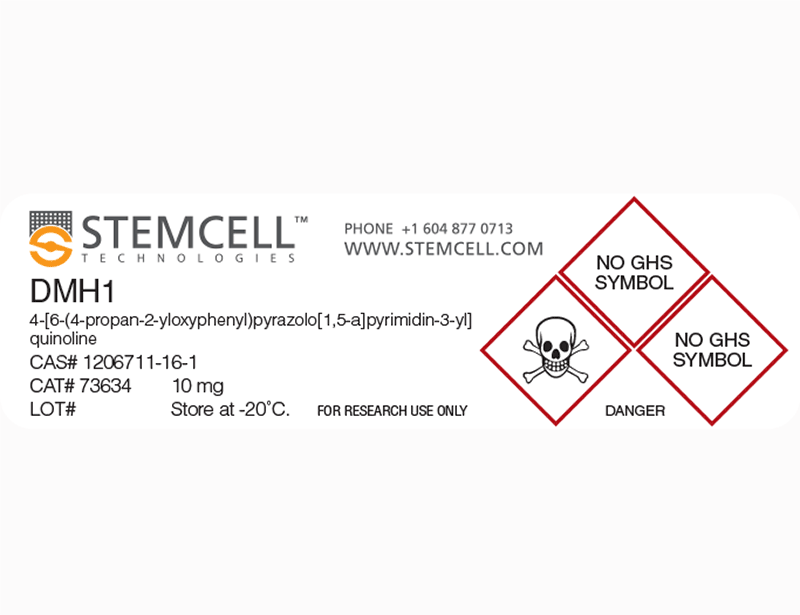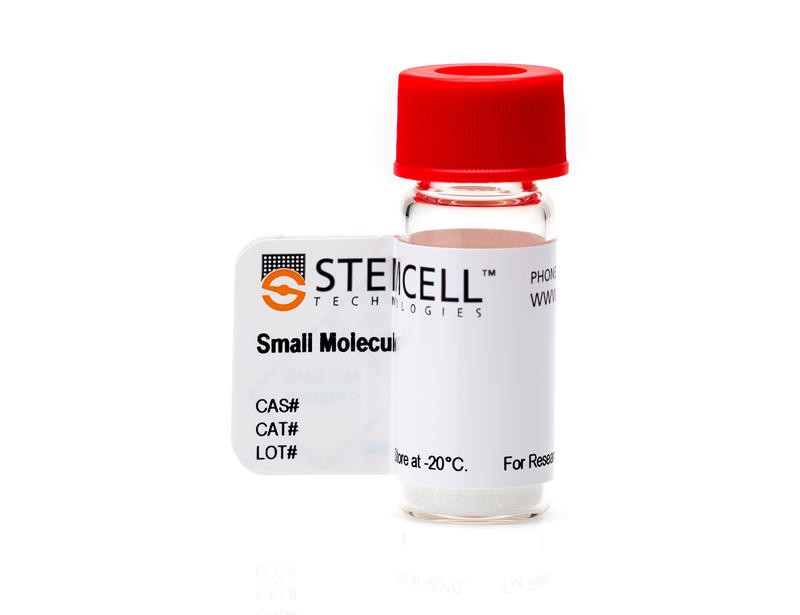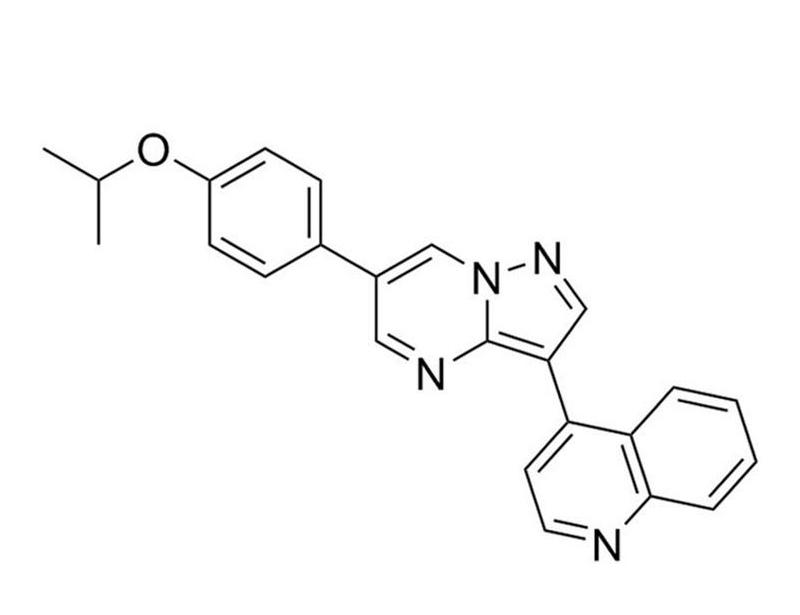概要
DMH1 (dorsomorphin homolog 1) is a selective inhibitor of activin receptor-like kinase 2 (ALK2; IC₅₀ = 13 - 108 nM), a type I bone morphogenetic protein (BMP) receptor (Hao et al.; Mohedas et al.). DMH1 exhibits no detectable inhibition of ALK4, ALK5, AMPK, KDR (VEGFR2), or PDGFRβ, although it inhibits ALK1 and ALK3 at nanomolar concentrations (Hao et al.; Mohedas et al.).
DIFFERENTIATION
· Induces differentiation of mouse embryonic stem cells to cardiomyocyte progenitor cells (Ao et al.).
· Induces differentiation of human induced pluripotent stem cells to SOX1 and PAX6 expressing neural precursor cells (Neely et al.).
· Dorsalizes the embryonic axis without disrupting the angiogenic process in early zebrafish embryos (Hao et al. 2010).
CANCER RESEARCH
· Suppresses non-small cell lung cancer cell growth, migration and invasion in vitro, and attenuates xenografted lung tumor growth in vivo (Hao et al. 2014).
· Inhibits chemotherapeutic drug-induced autophagy response (Sheng et al.).
DIFFERENTIATION
· Induces differentiation of mouse embryonic stem cells to cardiomyocyte progenitor cells (Ao et al.).
· Induces differentiation of human induced pluripotent stem cells to SOX1 and PAX6 expressing neural precursor cells (Neely et al.).
· Dorsalizes the embryonic axis without disrupting the angiogenic process in early zebrafish embryos (Hao et al. 2010).
CANCER RESEARCH
· Suppresses non-small cell lung cancer cell growth, migration and invasion in vitro, and attenuates xenografted lung tumor growth in vivo (Hao et al. 2014).
· Inhibits chemotherapeutic drug-induced autophagy response (Sheng et al.).
技术资料
| Document Type | 产品名称 | Catalog # | Lot # | 语言 |
|---|---|---|---|---|
| Product Information Sheet | DMH1 | 73632, 73634 | All | English |
| Safety Data Sheet | DMH1 | 73632, 73634 | All | English |
数据及文献
Publications (7)
Acta pharmaceutica Sinica. B 2015 JUL
DMH1 (4-[6-(4-isopropoxyphenyl)pyrazolo[1,5-a]pyrimidin-3-yl]quinoline) inhibits chemotherapeutic drug-induced autophagy.
Abstract
Abstract
Our previous work found that DMH1 (4-[6-(4-isopropoxyphenyl)pyrazolo [1,5-a]pyrimidin-3-yl]quinoline) was a novel autophagy inhibitor. Here, we aimed to investigate the effects of DMH1 on chemotherapeutic drug-induced autophagy as well as the efficacy of chemotherapeutic drugs in different cancer cells. We found that DMH1 inhibited tamoxifen- and cispcis-diaminedichloroplatinum (II) (CDDP)-induced autophagy responses in MCF-7 and HeLa cells, and potentiated the anti-tumor activity of tamoxifen and CDDP for both cells. DMH1 inhibited 5-fluorouracil (5-FU)-induced autophagy responses in MCF-7 and HeLa cells, but did not affect the anti-tumor activity of 5-FU for these two cell lines. DMH1 itself did not induce cell death in MCF-7 and HeLa cells, but inhibited the proliferation of these cells. In conclusion, DMH1 inhibits chemotherapeutic drug-induced autophagy response and the enhancement of efficacy of chemotherapeutic drugs by DMH1 is dependent on the cell sensitivity to drugs.
PloS one 2014 JAN
DMH1, a small molecule inhibitor of BMP type i receptors, suppresses growth and invasion of lung cancer.
Abstract
Abstract
The bone morphogenetic protein (BMP) signaling cascade is aberrantly activated in human non-small cell lung cancer (NSCLC) but not in normal lung epithelial cells, suggesting that blocking BMP signaling may be an effective therapeutic approach for lung cancer. Previous studies demonstrated that some BMP antagonists, which bind to extracellular BMP ligands and prevent their association with BMP receptors, dramatically reduced lung tumor growth. However, clinical application of protein-based BMP antagonists is limited by short half-lives, poor intra-tumor delivery as well as resistance caused by potential gain-of-function mutations in the downstream of the BMP pathway. Small molecule BMP inhibitors which target the intracellular BMP cascades would be ideal for anticancer drug development. In a zebrafish embryo-based structure and activity study, we previously identified a group of highly selective small molecule inhibitors specifically antagonizing the intracellular kinase domain of BMP type I receptors. In the present study, we demonstrated that DMH1, one of such inhibitors, potently reduced lung cell proliferation, promoted cell death, and decreased cell migration and invasion in NSCLC cells by blocking BMP signaling, as indicated by suppression of Smad 1/5/8 phosphorylation and gene expression of Id1, Id2 and Id3. Additionally, DMH1 treatment significantly reduced the tumor growth in human lung cancer xenograft model. In conclusion, our study indicates that small molecule inhibitors of BMP type I receptors may offer a promising novel strategy for lung cancer treatment.
ACS chemical biology 2013 JAN
Development of an ALK2-biased BMP type I receptor kinase inhibitor.
Abstract
Abstract
The bone morphogenetic protein (BMP) signaling pathway has essential functions in development, homeostasis, and the normal and pathophysiologic remodeling of tissues. Small molecule inhibitors of the BMP receptor kinase family have been useful for probing physiologic functions of BMP signaling in vitro and in vivo and may have roles in the treatment of BMP-mediated diseases. Here we describe the development of a selective and potent inhibitor of the BMP type I receptor kinases, LDN-212854, which in contrast to previously described BMP receptor kinase inhibitors exhibits nearly 4 orders of selectivity for BMP versus the closely related TGF-β and Activin type I receptors. In vitro, LDN-212854 exhibits some selectivity for ALK2 in preference to other BMP type I receptors, ALK1 and ALK3, which may permit the interrogation of ALK2-mediated signaling, transcriptional activity, and function. LDN-212854 potently inhibits heterotopic ossification in an inducible transgenic mutant ALK2 mouse model of fibrodysplasia ossificans progressiva. These findings represent a significant step toward developing selective inhibitors targeting individual members of the highly homologous BMP type I receptor family. Such inhibitors would provide greater resolution as probes of physiologic function and improved selectivity against therapeutic targets.
ACS chemical neuroscience 2012 JUN
DMH1, a highly selective small molecule BMP inhibitor promotes neurogenesis of hiPSCs: comparison of PAX6 and SOX1 expression during neural induction.
Abstract
Abstract
Recent successes in deriving human-induced pluripotent stem cells (hiPSCs) allow for the possibility of studying human neurons derived from patients with neurological diseases. Concomitant inhibition of the BMP and TGF-β1 branches of the TGF-β signaling pathways by the endogenous antagonist, Noggin, and the small molecule SB431542, respectively, induces efficient neuralization of hiPSCs, a method known as dual-SMAD inhibition. The use of small molecule inhibitors instead of their endogenous counterparts has several advantages including lower cost, consistent activity, and the maintenance of xeno-free culture conditions. We tested the efficacy of DMH1, a highly selective small molecule BMP-inhibitor for its potential to replace Noggin in the neuralization of hiPSCs. We compare Noggin and DMH1-induced neuralization of hiPSCs by measuring protein and mRNA levels of pluripotency and neural precursor markers over a period of seven days. The regulation of five of the six markers assessed was indistinguishable in the presence of concentrations of Noggin or DMH1 that have been shown to effectively inhibit BMP signaling in other systems. We observed that by varying the DMH1 or Noggin concentration, we could selectively modulate the number of SOX1 expressing cells, whereas PAX6, another neural precursor marker, remained the same. The level and timing of SOX1 expression have been shown to affect neural induction as well as neural lineage. Our observations, therefore, suggest that BMP-inhibitor concentrations need to be carefully monitored to ensure appropriate expression levels of all transcription factors necessary for the induction of a particular neuronal lineage. We further demonstrate that DMH1-induced neural progenitors can be differentiated into β3-tubulin expressing neurons, a subset of which also express tyrosine hydroxylase. Thus, the combined use of DMH1, a highly specific BMP-pathway inhibitor, and SB431542, a TGF-β1-pathway specific inhibitor, provides us with the tools to independently regulate these two pathways through the exclusive use of small molecule inhibitors.
PloS one 2012 JAN
DMH1, a novel BMP small molecule inhibitor, increases cardiomyocyte progenitors and promotes cardiac differentiation in mouse embryonic stem cells.
Abstract
Abstract
The possibility of using cell-based therapeutics to treat cardiac failure has generated significant interest since the initial introduction of stem cell-based technologies. However, the methods to quickly and robustly direct stem cell differentiation towards cardiac cell types have been limited by a reliance on recombinant growth factors to provide necessary biological cues. We report here the use of dorsomorphin homologue 1 (DMH1), a second-generation small molecule BMP inhibitor based on dorsomorphin, to efficiently induce beating cardiomyocyte formation in mouse embryonic stem cells (ESCs) and to specifically upregulate canonical transcriptional markers associated with cardiac development. DMH1 differs significantly from its predecessor by its ability to enrich for pro-cardiac progenitor cells that respond to late-stage Wnt inhibition using XAV939 and produce secondary beating cardiomyocytes. Our study demonstrates the utility of small molecules to complement existing in vitro cardiac differentiation protocols and highlights the role of transient BMP inhibition in cardiomyogenesis.
Chemical Society reviews 2011 AUG
Chemical 'Jekyll and Hyde's: small-molecule inhibitors of developmental signaling pathways.
Abstract
Abstract
Small molecules that perturb developmental signaling pathways can have devastating effects on embryonic patterning, as evidenced by the chemically induced onset of cyclopic lambs and children with severely shortened limbs during the 1950s. Recent studies, however, have revealed critical roles for these pathways in human disorders and diseases, spurring the re-examination of these compounds as new targeted therapies. In this tutorial review, we describe four case studies of teratogenic compounds, including inhibitors of the Hedgehog (Hh), Wnt, and bone morphogenetic protein (BMP) pathways. We discuss how these teratogens were discovered, their mechanisms of action, their utility as molecular probes, and their potential as therapeutic agents. We also consider current challenges in the field and possible directions for future research.

 网站首页
网站首页





